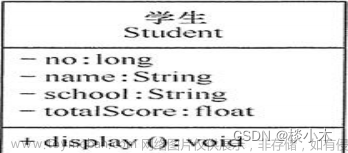1、开闭原则(Open-closed Principle)
开闭原则,是面向设计中最基础的设计原则。
一个软件实体类、模块、函数应该对扩展开放、对修改关闭。
强调的是用抽象构建框架,用实现扩展细节。可以提高软件系统的可复用性和可维护性。
实例:文章来源:https://www.toymoban.com/news/detail-606819.html
public interface ICourse {
Integer getId();
String getName();
Double getPrice();
}
public class JavaCourse implements ICourse{
private Integer id;
private String name;
private Double price;
public Integer getId() {
return this.id;
}
public String getName() {
return this.name;
}
public Double getPrice() {
return this.price;
}
public JavaCourse(Integer id, String name, Double price) {
this.id = id;
this.name = name;
this.price = price;
}
}
public class JavaDiscountCourse extends JavaCourse {
public JavaDiscountCourse(Integer id, String name, Double price) {
super(id, name, price);
}
public Double getOriginPrice() {
return super.getPrice();
}
public Double getPrice() {
return super.getPrice() * 0.6;
}
}
2、本末倒置原则(Dependence Inversion Principle)
高层模块不应该依赖底层模块,二者都应该依赖其抽象。
抽象不应该依赖细节,细节应该依赖抽象。
本末倒置可以减少类与类之间的耦合性,提高系统的稳定性,提高代码的可读性和可维护性,降低修改程序造成的风险。
实例:
public interface ICourse {
void study();
}
public class JavaCourse implements ICourse{
@Override
public void study() {
System.out.println("学习Java");
}
}
public class PythonCourse implements ICourse{
@Override
public void study() {
System.out.println("学习Python");
}
}
/**
* 方式一:依赖注入,每次学习一个新课程就多创建一个类
*/
public class PersonOne {
public void study(ICourse iCourse){
iCourse.study();
}
public static void main(String[] args) {
PersonOne personOne = new PersonOne();
personOne.study(new JavaCourse());
personOne.study(new PythonCourse());
}
}
/**
* 方式二:构造器注入,调用时每次都要创建实例
*/
public class PersonTwo {
private ICourse iCourse;
public PersonTwo(ICourse iCourse) {
this.iCourse = iCourse;
}
public void study() {
iCourse.study();
}
public static void main(String[] args) {
PersonTwo personTwo = new PersonTwo(new JavaCourse());
personTwo.study();
}
}
/**
* 方式三:Setter方式注入
*/
public class PersonThree {
private ICourse iCourse;
public void setCourse(ICourse iCourse) {
this.iCourse = iCourse;
}
public void study() {
iCourse.study();
}
public static void main(String[] args) {
PersonThree personTwo = new PersonThree();
personTwo.setCourse(new JavaCourse());
personTwo.study();
}
}
3、单一职责(Simple Responsibility Principle)
不要存在多于一个导致类变更的原因
一个对象应该只包含单一的职责,并且该职责被完整地封装在一个类中。
/**
* course存在两种处理逻辑,这个地方修改代码
*/
public class Course {
public void study(String name){
if("直播".equals(name)){
System.out.println("不能快进");
}else {
System.out.println("2xx倍速");
}
}
public static void main(String[] args) {
Course course = new Course();
course.study("直播");
}
}
修改下的代码,这样把两个课程给分开控制。
public class LiveCourse {
public void study(String name){
System.out.println("不能快进");
}
}
public class ReplayCourse {
public void study(String name){
System.out.println("2xx倍速");
}
}
public class Test {
public static void main(String[] args) {
LiveCourse liveCourse = new LiveCourse();
liveCourse.study("直播");
ReplayCourse replayCourse = new ReplayCourse();
replayCourse.study("测试");
}
}`在这里插入代码片`
4、接口隔离原则(Interface Segregation Principle)
用多个专门的接口,而不使用单一的接口,客户端不应该依赖它不需要的接口
- 一个类对一类的依赖应该建立在最小的接口上
- 建立单一接口,不要建立庞大的接口
- 尽量细化接口,接口中的方法尽量少
实例:
public interface Animal {
void eat();
void fly();
void swimming();
}
public class Bird implements Animal{
@Override
public void eat() {
}
@Override
public void fly() {
}
@Override
public void swimming() {
}
}
public class Dag implements Animal{
@Override
public void eat() {
}
@Override
public void fly() {
}
@Override
public void swimming() {
}
}
当dog不能飞,鸟儿不能游泳的时候,这个方法就会空,这时候需要根据动物行为设计不同的接口
public interface EatAnimal {
void eat();
}
public interface FlyAnimal {
void fly();
}
public interface SwimmingAnimal {
void swimming();
}
public class Dog implements SwimmingAnimal, EatAnimal{
@Override
public void eat() {
}
@Override
public void swimming() {
}
}
5、迪米特法则(Law of demeter LoD)
一个对象应该对其他对象保持最少的了解。只和朋友交流,不喝陌生人说话。
出现在成员变量、方法的输入、输出参数中的类都可以称为成员朋友类,出现在方法体内内部的类不属于朋友类。
实例:
public class Course {
}
public class Employee {
public void checkNumOfCourse(List<Course> courseList) {
System.out.println("课程数量" + courseList.size());
}
}
public class Leader {
public void CommandCheckNumber(Employee employee){
List<Course> courseList = new ArrayList<Course>();
for (int i = 0; i < 20; i++) {
courseList.add(new Course());
}
employee.checkNumOfCourse(courseList);
}
public static void main(String[] args) {
Leader leader = new Leader();
Employee employee = new Employee();
leader.CommandCheckNumber(employee);
}
}
根据迪米特法则,Leader只想要结果,不需要和Course有直接的接触,所以这个地方修改
public class EmployeeCp {
public void checkNumOfCourse() {
List<Course> courseList = new ArrayList<Course>();
for (int i = 0; i < 20; i++) {
courseList.add(new Course());
}
System.out.println("课程数量" + courseList.size());
}
}
public class LeaderCp {
public void CommandCheckNumber(EmployeeCp employee){
employee.checkNumOfCourse();
}
public static void main(String[] args) {
LeaderCp leader = new LeaderCp();
EmployeeCp employee = new EmployeeCp();
leader.CommandCheckNumber(employee);
}
}
6、里氏替换原则(Liskov Substitution Priciple)
如果针对一个类型为T1的对象O1,都有类型T2的对象O2,使得以T1定义的所有程序P在所有的对象O1都替换成O2时,程序P的行为没有发生变化,那么类型T2还是类型T1的子类型。
1)子类可以实现父类的抽象方法,但不能覆盖父类的非抽象方法
2)子类仲可以增加自己特有的方法
3)当子类的方法重载父类的方法时,方法的前置条件(入参)要比父类方法的输入参数更宽松
4)当子类的方法实现
父类的方法时,方法的后置条件(输出/返回值)要比父类更严格或相等
优点:
1)约束继承泛滥,开闭原则的一种体现
2)加签程序的健壮性,同时变更也可以做到好的兼容,提高程序的维护性、扩展性,降低需求变更时的风险
实例:
public class Rectangle {
private Long height;
private Long width;
public Long getHeight() {
return height;
}
public Long getWidth() {
return width;
}
public void setHeight(Long height) {
this.height = height;
}
public void setWidth(Long width) {
this.width = width;
}
}
public class Square extends Rectangle {
private Long length;
public Long getLength() {
return length;
}
public void setLength(Long length) {
this.length = length;
}
@Override
public Long getHeight() {
return getLength();
}
@Override
public void setHeight(Long height) {
setLength(height);
}
@Override
public Long getWidth() {
return getLength();
}
@Override
public void setWidth(Long width) {
setLength(width);
}
}
public class Test {
public static void resize(Rectangle rectangle){
while (rectangle.getWidth() >= rectangle.getHeight()){
rectangle.setHeight(rectangle.getHeight()+1);
System.out.printf("width: %s, height:%s", rectangle.getWidth(), rectangle.getHeight());
}
System.out.printf("width: %s, height:%s", rectangle.getWidth(), rectangle.getHeight());
}
public static void main(String[] args) {
Rectangle rectangle = new Rectangle();
rectangle.setWidth(20L);
rectangle.setHeight(10L);
resize(rectangle);
//死循环
Square square = new Square();
square.setLength(10L);
resize(square);
}
}
当是正方形的时候,陷入死循环,违背里氏替换原则,父类替换成子类后结果不是预期。
修改代码,创建一个抽象四边形
public interface QuadRectangle {
Long getWidth();
Long getHeight();
}
public class RectangleCp implements QuadRectangle{
private Long height;
private Long width;
public Long getHeight() {
return height;
}
public Long getWidth() {
return width;
}
public void setHeight(Long height) {
this.height = height;
}
public void setWidth(Long width) {
this.width = width;
}
}
public class SquareCp implements QuadRectangle {
private Long length;
public Long getLength() {
return length;
}
public void setLength(Long length) {
this.length = length;
}
@Override
public Long getHeight() {
return getLength();
}
@Override
public Long getWidth() {
return getLength();
}
}
7、合成复用原则(Composite Reuse Principle)
尽量使用对象组合(has-a)/聚合(contain-a),而不是继承达到软件复用的目的。
继承叫做“白箱复用”,把所有的实现细节暴露给子类
组合/聚合称为“黑箱复用”,对类以外的对象是无法获取到实现细节的
实例:
public class DBConnection {
public String getConnection() {
return "MySql连接";
}
}
public class ProductDao {
private DBConnection dbConnection;
public void setDbConnection(DBConnection dbConnection){
this.dbConnection = dbConnection;
}
public void addProduct(){
String conn = dbConnection.getConnection();
System.out.println("创建商品");
}
}
如果这时候不只是mysql还有其他类型的数据库,违反开闭原则
修改代码:文章来源地址https://www.toymoban.com/news/detail-606819.html
public abstract class DBConnectionCp {
public abstract String getConnection();
}
public class MysqlConnection extends DBConnection{
@Override
public String getConnection() {
return "mysql";
}
}
public class OracleConnection extends DBConnection{
@Override
public String getConnection() {
return "Oracle";
}
}
到了这里,关于七大设计模式原则的文章就介绍完了。如果您还想了解更多内容,请在右上角搜索TOY模板网以前的文章或继续浏览下面的相关文章,希望大家以后多多支持TOY模板网!







